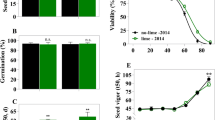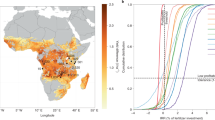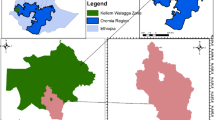Abstract
Acid soils are widespread across sub-Saharan Africa. Agricultural lime can be used to alleviate production constraints associated with soil acidity, but lime is not widely available in the region, and it is unclear if applying it would be profitable. Using lime requirement models and crop yield responses to soil acidity modelled as plateau–linear decay functions, we estimated the profitability of acid soil remediation through liming. Crop yield loss to soil acidity occurs on 32.7 Mha, or 23% of sub-Saharan Africa’s cropland. The burden of acid soils is US$6.0 billion (6% of the current production value), and 75% of that could be profitably alleviated. Under prevailing conditions, liming would be profitable in the year of application on 6.2 Mha (with an average profitability of US$278 ha−1) and on 8.8 Mha when lime’s long-term effect is considered. Intensification of crop production and lower relative lime/output prices could make liming profitable on more cropland.
This is a preview of subscription content, access via your institution
Access options
Access Nature and 54 other Nature Portfolio journals
Get Nature+, our best-value online-access subscription
$32.99 / 30 days
cancel any time
Subscribe to this journal
Receive 12 digital issues and online access to articles
$119.00 per year
only $9.92 per issue
Buy this article
- Purchase on SpringerLink
- Instant access to full article PDF
Prices may be subject to local taxes which are calculated during checkout





Similar content being viewed by others
Data availability
The spatial data and tabular aggregates from our results are available at www.acidsoils.africa. Soil data from Hengl et al.45 can be accessed at https://www.isric.org/projects/soil-property-maps-africa-250-m-resolution. Crop area and production data from IFPRI51 can be accessed at https://doi.org/10.7910/DVN/PRFF8V.
Code availability
The R scripts developed for the analyses presented in the manuscript are available via GitHub at https://github.com/EiA2030-ex-ante/gaia-ex-ante-wow.
References
Sánchez, P. A. Properties and Management of Soils in the Tropics Ch. 9 (Cambridge Univ. Press, 2019).
Sánchez, P. A. & Salinas, J. G. Low-input technology for managing Oxisols and Ultisols in tropical America. Adv. Agron. https://doi.org/10.1016/S0065-2113(08)60889-5 (1981).
Kamprath, E. J. Exchangeable aluminum as a criterion for liming leached mineral soils. Soil Sci. Soc. Am. 11, 1–40 (1970).
Fageria, N. K. & Baligar, V. C. Chapter 7 ameliorating soil acidity of tropical Oxisols by liming for sustainable crop production. Adv. Agron. https://doi.org/10.1016/S0065-2113(08)00407-0 (2008).
Yamada, T. The Cerrado of Brazil: a success story of production on acid soils. Soil Sci. Plant Nutr. 51, 617–620 (2005).
Pauw, E. F. D. The management of acid soils in Africa. Outlook Agric. 23, 11–16 (1994).
Goedert, W. J. Management of the Cerrado soils of Brazil: a review. J. Soil Sci. 34, 405–428 (1983).
Coleman, N. T., Kamprath, E. J. & Weed, S. B. Liming. Adv. Agron. https://doi.org/10.1016/S0065-2113(08)60073-5 (1959).
Vanlauwe, B. et al. Integrated soil fertility management in sub-Saharan Africa: unravelling local adaptation. SOIL 1, 491–508 (2015).
Vanlauwe, B. et al. Sustainable intensification and the African smallholder farmer. Curr. Opin. Environ. Sustain. 8, 15–22 (2014).
Tittonell, P. & Giller, K. E. When yield gaps are poverty traps: the paradigm of ecological intensification in African smallholder agriculture. Field Crops Res. 143, 76–90 (2013).
Eswaran, H., Almaraz, R., van den Berg, E. & Reich, P. An assessment of the soil resources of Africa in relation to productivity. Geoderma 77, 1–18 (1997).
Pieri, C., Dumanski, J. & Hamblin, A. Y. Land quality indicators (English) World Bank discussion papers (The World Bank, 1995); http://documents.worldbank.org/curated/en/405971468739495480
Mendes, A. P., Farina, M. P. W., Channon, P. & Smith, M. A field evaluation of the differential tolerance to soil acidity of forty-eight South African maize cultivars. S. Afr. J. Plant Soil 2, 215–220 (1985).
Uwiragiye, Y. et al. Spatial prediction of lime requirements by adjusting aluminium saturation in sub-Saharan Africa croplands. Sci. Total Environ. 908, 167989 (2024).
Agegnehu, G. et al. Extent and management of acid soils for sustainable crop production system in the tropical agroecosystems: a review. Acta Agric. Scand. B 71, 852–869 (2021).
Gurmessa, B. Soil acidity challenges and the significance of liming and organic amendments in tropical agricultural lands with reference to Ethiopia. Environ. Dev. Sustain. 23, 77 – 99 (2021).
Nduwumuremyi, A. Soil acidification and lime quality: sources of soil acidity, effects on plant nutrients, efficiency of lime and liming requirements. Res. Rev. J. Agric. Allied Sci. 2, 26–34 (2013).
Desalegn, T., Alemu, G., Adella, A., Debele, T. & Gonzalo, J. J. Effect of lime and phosphorus fertilizer on acid soils and barley (Hordeum vulgare L.) performance in the central highlands of Ethiopia. Exp. Agric. 53, 432–444 (2017).
Kisinyo, P. O. et al. Immediate and residual effects of lime and phosphorus fertilizer on soil acidity and maize production in Western Kenya. Exp. Agric. 50, 128–143 (2014).
Farina, M. P. W. & Channon, P. A field comparison of lime requirement indices for maize. Plant Soil 134, 127–135 (1991).
Llewellyn, R. S. & Brown, B. Predicting adoption of innovations by farmers: what is different in smallholder agriculture? Appl. Econ. Perspect. Policy 42, 100–112 (2020).
Shiferaw, B. A., Okello, J. & Reddy, R. V. Adoption and adaptation of natural resource management innovations in smallholder agriculture: reflections on key lessons and best practices. Environ. Dev. Sustain. 11, 601–619 (2009).
Lee, D. R. Agricultural sustainability and technology adoption: issues and policies for developing countries. Am. J. Agric. Econ. 87, 1325–1334 (2005).
Lollato, R. P., Ochsner, T. E., Arnall, D. B., Griffin, T. W. & Edwards, J. T. From field experiments to regional forecasts: upscaling wheat grain and forage yield response to acidic soils. Agron. J. 111, 287–302 (2019).
Abruña Rodríguez, F., Vicente-Chandler, J., Rivera, E. & Rodríguez, J. Effect of soil acidity factors on yields and foliar composition of tropical root crops. Soil Sci. Soc. Am. J. 46, 1004–1007 (1982).
von Uexkull, H. R. & Mutert, E. Global extent, development and economic impact of acid soils. Plant Soil 171, 1 – 15 (1995).
Sumner, M. E. & Noble, A. D. in Handbook of Soil Acidity (ed Rengel, Z.) Ch. 1 (Academic Press, 2003).
Fageria, N. K. & Nascente, A. S. Chapter six management of soil acidity of South American soils for sustainable crop production. Adv. Agron. https://doi.org/10.1016/B978-0-12-802139-2.00006-8 (2014).
Silva, J. V. et al. Narrowing maize yield gaps across smallholder farming systems in Zambia: what interventions, where, and for whom? Agron. Sustain. Dev. 43, 26 (2023).
Assefa, B. T., Chamberlin, J., Reidsma, P., Silva, J. V. & van Ittersum, M. K. Unravelling the variability and causes of smallholder maize yield gaps in Ethiopia. Food Secur. 12, 83–103 (2020).
Aramburu-Merlos, F. et al. Adopting yield-improving practices to meet maize demand in Sub-Saharan Africa without cropland expansion. Nat. Commun. 15, 4492 (2024).
Bonilla-Cedrez, C., Chamberlin, J. & Hijmans, R. J. Fertilizer and grain prices constrain food production in sub-Saharan Africa. Nat. Food 2, 766–772 (2021).
de Wit, C. T. Resource use efficiency in agriculture. Agric. Syst. 40, 125 151 (1992).
Alemayehu, M., Beuving, J. & Ruben, R. Disentangling poor smallholder farmers’ risk preferences and time horizons: evidence from a field experiment in Ethiopia. Eur. J. Dev. Res. 31, 558–580 (2019).
Karlan, D., Osei, R., Osei-Akoto, I. & Udry, C. Agricultural decisions after relaxing credit and risk constraints. Q. J. Econ. 129, 597–652 (2014).
Giller, K. E. et al. Communicating complexity: integrated assessment of trade-offs concerning soil fertility management within African farming systems to support innovation and development. Agric. Syst. 104, 191–203 (2011).
Holden, S. T., Binswanger, H. P. & Lutz, E. Small-farmer decision-making, market imperfections, and natural resource management in developing countries. in Agriculture and the Environment. Perspectives on Sustainable Rural Development (eds Lutz, E. et al.) 50–70 (The World Bank, 1998).
Cifu, M., Xiaonan, L., Zhihong, C., Zhengyi, H. & Wanzhu, M. Long-term effects of lime application on soil acidity and crop yields on a red soil in Central Zhejiang. Plant Soil 265, 101–109 (2004).
Mokolobate, M. & Haynes, R. Comparative liming effect of four organic residues applied to an acid soil. Biol. Fertil. Soils 35, 75–89 (2002).
Stromgaard, P. Immediate and long-term effects of fire and ash-fertilization on a Zambian miombo woodland soil. Agric. Ecosyst. Environ. 41, 19–37 (1992).
Chidumayo, E. N. A shifting cultivation land use system under population pressure in Zambia. Agrofor. Syst. 5, 15–25 (1987).
Golla, A. S. Soil acidity and its management options in Ethiopia: a review. Int. J. Sci. Res. Manage. 7, 1429–1440 (2019).
Haynes, R. J. Effects of liming on phosphate availability in acid soils: a critical review. Plant Soil 68, 289–308 (1982).
Hengl, T. et al. SoilGrids250m: global gridded soil information based on machine learning. PLoS One 12, 1–40 (2017).
Oumer, A. M., Diro, S., Taye, G., Mamo, T. & Jaleta, M. Agricultural lime value chain efficiency for reducing soil acidity in Ethiopia. Soil Security 11, 100092 (2023).
Bonilla Cedrez, C., Chamberlin, J., Guo, Z. & Hijmans, R. J. Spatial variation in fertilizer prices in sub-Saharan Africa. PLoS One 15, 1–20 (2020).
Fertilizer Supply and Costs in Africa. https://doi.org/10.21955/gatesopenres.1115134.1 (Bill and Melinda Gates Foundation, 2007).
Aramburu Merlos, F. limer: acidic soil management for agriculture. R package v.0.1-1 https://github.com/cropmodels/limer (2022).
Hijmans, R. J. Recocrop: estimating environmental suitability for plants. R package v.0.4-0 https://github.com/cropmodels/Recocrop/ (2021).
Global Spatially-Disaggregated Crop Production Statistics Data for 2010, v.2.0 https://doi.org/10.7910/DVN/PRFF8V (IFPRI, 2019).
Aramburu Merlos, F., Silva, J. V., Baudron, F. & Hijmans, R. J. Estimating lime requirements for tropical soils: model comparison and development. Geoderma 432, 116421 (2023).
Smyth, T. J. & Cravo, M. S. Aluminum and calcium constraints to continuous crop production in a Brazilian Amazon oxisol. Agron. J. 84, 843–850 (1992).
Cochrane, T. T., Salinas, J. G. & Sanchez, P. A. An equation for liming acid mineral soils to compensate crop aluminium tolerance. Trop. Agric. 57, 133–140 (1980).
Salinas, J. G. Differential Response of Some Cereal and Bean Cultivars to Al and P Stress in an Oxisol of Central Brazil. Ph.D. thesis, North Carolina State University (1978).
Hijmans, R. J., Barbosa, M., Ghosh, A. & Mandel, A. geodata: download geographic data, R package v.0.5-9 https://CRAN.R-project.org/package=geodata (2023).
Hijmans, R. J. terra: spatial data analysis, R package v.1.6-17 https://CRAN.R-project.org/package=terra (2022).
Acknowledgements
We gratefully acknowledge support for this study from the Bill & Melinda Gates Foundation, through the Guiding Acid Soil Management Investments in Africa (GAIA) project (grant number INV-068374), and from the OneCGIAR Initiative on Excellence in Agronomy (grant number INV-005431). We thank C. Witt, K. Giller, K. Shepherd, B. Vanlauwe, B. Gérard, M. Walsch and M. Farina for insightful comments on earlier versions of this manuscript.
Author information
Authors and Affiliations
Contributions
J.V.S., F.A.-M. and R.J.H. conceptualized the study and developed methodology and software for data acquisition, analysis and visualization. F.B. and J.C. supported the conceptualization of the study, validated methodology and results, and were responsible for funding acquisition and project administration. S.G., T.S.S., V.R., J.M. and M.J. were instrumental in the validation of the methods and the results, supervision of the research work, and project coordination in the respective countries. J.V.S. wrote the original draft. All authors edited and commented on the manuscript, particularly F.A.-M. and R.J.H.
Corresponding author
Ethics declarations
Competing interests
The authors declare no competing interests.
Peer review
Peer review information
Nature Food thanks Yves Uwiragiy, Jianbin Zhou and the other, anonymous, reviewer(s) for their contribution to the peer review of this work.
Additional information
Publisher’s note Springer Nature remains neutral with regard to jurisdictional claims in published maps and institutional affiliations.
Supplementary information
Supplementary Information
Supplementary Figs. 1–9 and Tables 1 and 2.
Rights and permissions
Springer Nature or its licensor (e.g. a society or other partner) holds exclusive rights to this article under a publishing agreement with the author(s) or other rightsholder(s); author self-archiving of the accepted manuscript version of this article is solely governed by the terms of such publishing agreement and applicable law.
About this article
Cite this article
Silva, J.V., Aramburu-Merlos, F., Baudron, F. et al. Soil acidity remediation in sub-Saharan Africa requires targeted investments. Nat Food 6, 799–808 (2025). https://doi.org/10.1038/s43016-025-01194-z
Received:
Accepted:
Published:
Issue date:
DOI: https://doi.org/10.1038/s43016-025-01194-z



